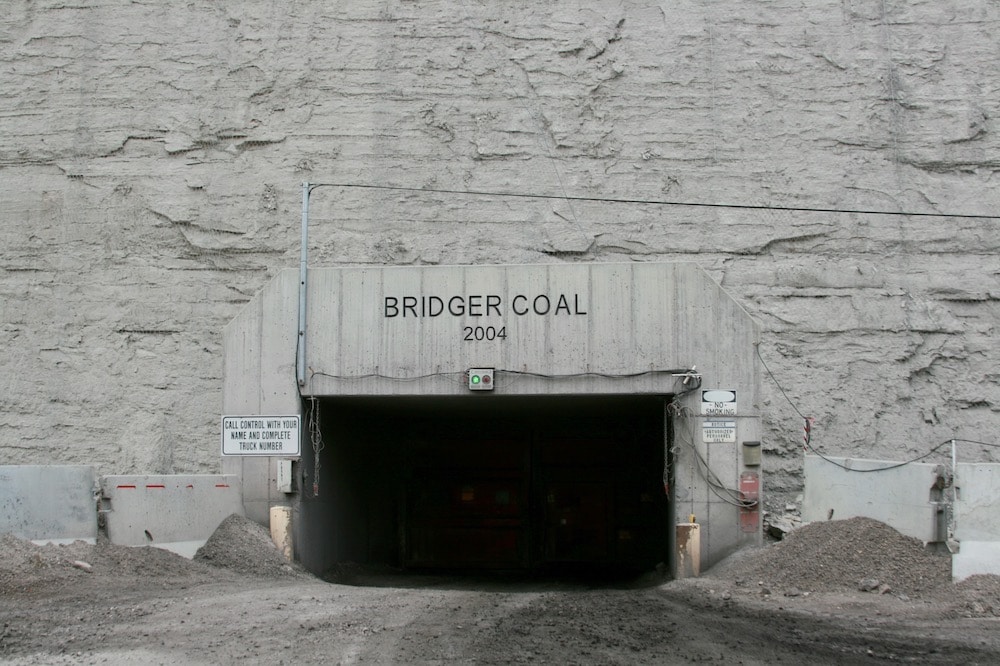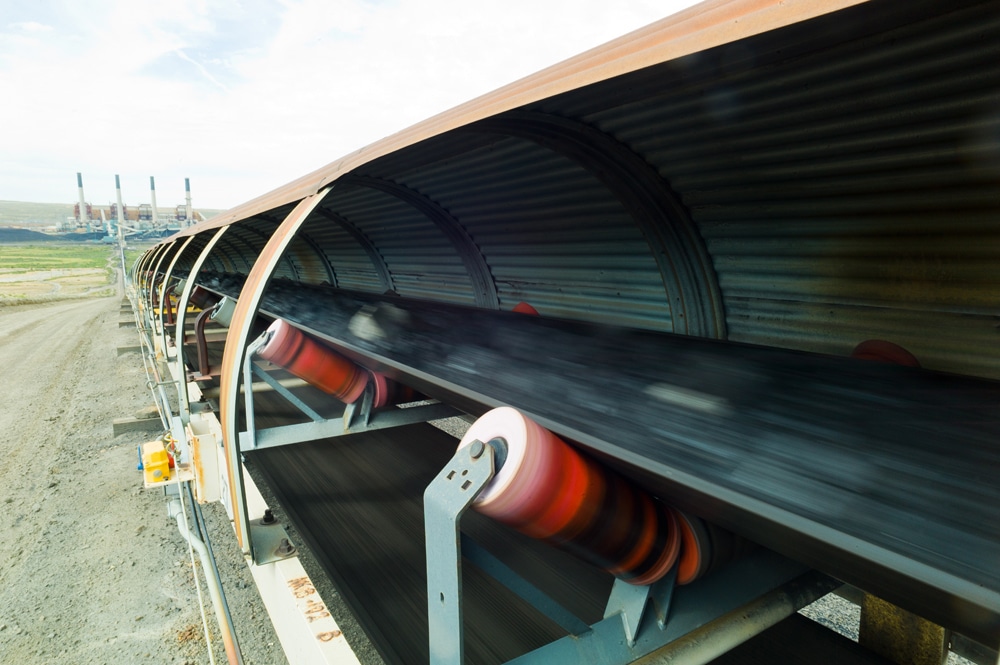Life Beneath the Earth in Wyoming's Only Underground Coal Mine

By Andrew Graham
September 3, 2019 - In the Bridger Underground Coal Mine, the roof, walls and ground underfoot are composed of the black rock. In a tunnel 700 feet under the earth, mine superintendent Bob Fox turns off the headlights of a specially modified pickup and the darkness becomes total.
Down here, miners are identifiable by the beam of their headlamps. In the chamber that marks the end of the mine and the locus of its activity, the helmet-mounted lights bob and stab as the longwall miner, a machine that peels the face of the coal seam, rips off chunks of coal with two circular saws.

Entrance to the Bridger Underground Coal Mine
Photo by Andrew Graham, WyoFile
Total darkness is just a light switch away and the earth above presses down around and behind the miners as the longwall miner grinds across the face, shearing a shower of black rock from the seam and sending flecks of it through the air. The noise thunders through the small chamber and it takes effort to speak over the grinding and hydraulic squeaking. When the longwall miner reaches the end of its run and falls silent, chunks of coal continue to flake off the wall with loud pops, evidence of the immense pressure from the earth above.
Wyoming’s coal mining industry is dominated by surface mining operations — complex enterprises that, nevertheless, resemble little more than giant pits. But here inside the state’s only underground coal mine, the engineering ingenuity and risk required to extricate energy is unmistakable, like a headlamp in pitch dark.
Underground coal mining is a vanishing art in Wyoming, however. Each chop of the longwall miner’s spinning metallic teeth brings this facility closer to the end of its life. Mining down here is expected to come to a halt in December 2021. Mine engineers have it calculated nearly to the day — the mine’s last day will be Dec. 9 or maybe Dec. 13, Fox said.
For the roughly 130 underground mine employees, the future is less clear than the closure date. That makes them nervous, Fox said.
“They don’t know what the future holds, if it’s with this company or trona or what,” he said. Coal leaves the mine on a conveyor belt, joining a two-mile system that hauls it from both underground and from the adjacent surface mine to the Jim Bridger Plant, the mines’ sole customer. The plant, which burns a blend of the two coals, faces an uncertain future in an era marked by concurrent trends: coal’s decline and natural gas and renewables’ rise.

A conveyor belt moves coal from both the underground and surface mine to the Jim Bridger Plant at a rate of 825 feet a minute.
Photo by M. Thuermer Jr., WyoFile
Trona mining, which is also done underground, offers hope for the underground coal miners as a next stop for their skills. That industry employed 2,225 employees statewide in 2018, according to the Wyoming Mining Association. The underground miners here are on the younger side, Fox said, many in their 30s. The profession is a lucrative one. Few mining jobs here pay less than $75,000 a year, even entry-level ones, said Scott Palmer, the Bridger Coal Company’s Manager of Technical Services.
It is also a dangerous profession. A miner died in this mine in September 2017, when a coal wall collapsed on top of him.
After the long wall miner has mined out a chunk of the coal seam, it has to advance. Behind the working miners, a hydraulic-powered roofing system props up the earth above them. When the miners advance that roof, the mine caves in behind them. The process produces a rumble down in the tunnels, an audible reminder of what’s on the other side of the machines.
“These are holding up the world,” Palmer said. “Behind us the world is collapsing.”
An older version of a longwall roof support, the piece of equipment that holds up the earth above miners as they mine along a coal seam with the longwall miner. (WyoFile was prohibited from taking photographs in the mine.) When the miners advance, they advance the roof supports with them. Behind the machine, underground, the earth then collapses in on the mined-out areas. (Andrew Graham/WyoFile)
Moving the long wall miner requires a carefully calibrated process stressful enough to take years off Fox’s life, joked the 62-year-old, a lifelong veteran of underground coal mines who has worked here since the mine’s beginning. Miners share the camaraderie of those who work a hazardous job and look out for each other, Fox said.
There are other, more continual hazards to working underground. Miners pump 3,500 gallons of water a minute out of the mine and spray some of it across the coal face and floor in an effort to keep the coal dust down — black lung, an underground miner’s affliction, remains a concern though miners here say newer technologies are effective protections.
They travel to their shifts in a personnel carrier. They work 12-hour shifts and eat their meals underground at a mobile “kitchen” equipped with a microwave. Work comes in four-day blocks, Fox said. Working the day shift means four days lived in the dark.
They Followed the Coal Seam
Bridger Coal Company, the mining subsidiary of PacifiCorp, did not originally plan to dig underground. The company started mining on the surface in the 1970s when the power plant was built. By the 2000s, surface mining was becoming more costly — the 30-foot coal seam they’d been mining split, Palmer said. One seam headed downward, and the amount of earth that had to be removed to get to the coal continued to increase.
In 2003, the miners began highwall mining. Highwall mining utilizes an automated miner to drive into the earth along the coal seam at the bottom of a surface mining pit. The miner brings out coal but is limited in how far it can dig. By 2004, the company had opened the underground mine to follow the seam under the earth.
Scott Palmer, chief engineer at the surface mine, stands next to an unearthed seam of coal. The coal seam miners began harvesting for the Jim Bridger Plant split into two seams, one of which miners followed underground beginning in 2004. (Andrew Graham/WyoFile)
Since then, the miners have been harvesting the coal in 600-foot-wide panels. They have mined out 20 panels. There are two remaining in their leased area. They are scheduled to reach the end of the final panel at the mine’s end date in December 2021.
To mine more coal underground would require a new federal lease, and a spokesperson for mine owner Pacificorp, says they won’t go through that onerous process. The underground miners’ work will be done.
Once the mine is closed, the ramp plunging into the tunnel in the bottom of the former pit will be filled — a process similar to the reclamation that happens to surface pit mines. The direction of the ramp will be reversed, Palmer said, and it will become shaped as a drainage to match the landscape.
The reclamation process restores the land to the appearance it held before coal mining, Palmer said. It takes a trained eye to detect the major difference — the disappearance of the bedrock coal. Reclaimed mine land is replanted with native grasses, and is attractive to wildlife, Palmer said, an assertion supported by the number of elk and wild horses roaming the mine property during WyoFile’s visit.
Reclamation takes 10 years, Palmer said. The underground mine will be reclaimed by 2031.
“There will be elk walking on it,” Palmer said. By then, uninformed visitors likely won’t know that once men and women labored in dangerous conditions deep in the darkness to light America’s homes and businesses.

